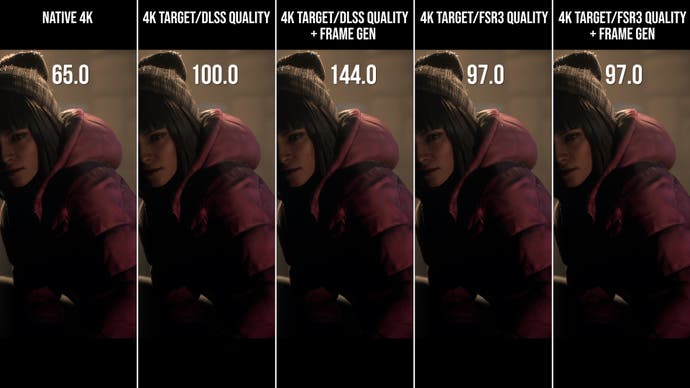Until Dawn's 1.05 update doesn't redeem a disastrous launch
Some fixes and new issues manifest in PC and PS5 code.
We've already touched on the disappointing state in which the Until Dawn remake arrived on PS5 back in DF Weekly #183, but how does the narrative horror game fare on PC - and have its rough edges been smoothed out on both platforms with subsequent patches?
Before we get into the current state of the game, it's worth covering off the basics of exactly what this remake is: a translation of the game from Guerilla's Decima engine to the ubiquitous Unreal Engine 5. The new renderer allows for higher-grade materials, shadows, volumetric effects, modern upscaling tech and even RT features, while still using the original motion capture data. The Until Dawn remake is also a remix of sorts, with re-edited in-engine cutscenes, extra playable segments and a fully-controllable camera in most scenes as well. It's impressive stuff, but the technical achievements here are let down by some glaring errors in terms of frame delivery and image quality, not to mention out-and-out bugs.
You'd expect that fixing technical faults and making the game look its best would be of some significance to developer Ballistic Moon and publisher Sony, given that a handful of the studio's staff worked on the 2015 original and there's a major motion picture (and a potential sequel) on the way. Indeed, there have been a number of updates, all the way up to the version 1.05 we used for testing today, but unfortunately not everything has been squared away just yet.
Starting with PS5, our testing on the latest patch shows one major improvement versus the launch code: proper frame pacing at the game's 30fps cap. This is great news, and while it's still possible to encounter hiccups under 30fps during camera cuts during in-engine cutscenes, patch 1.05 runs significantly smoother in motion than 1.04.
Unfortunately, some of the remake's other issues remain. The film grain, which seems to update at a a distracting-low 15fps, is still worth disabling in the options menu. (This is also true of the PC release, remarkably!)
More glaring is the choppy state of the pre-rendered cutscenes, which appeared to be fixed in version 1.04 but have now returned in full force on 1.05. We're talking full screen tearing, producing judder and a broken image, making for a distinctly poor first impression during the game's opener. Later cutscenes tend to be in-engine, thankfully, but this is still a disappointing turnout.
Otherwise, the PS5 version does have its benefits. It runs at a typical internal resolution of 1800p in most play - dynamically adjusting between 1440p and 4K - with better anti-aliasing and edge treatment than the PS4 original could muster. Shadows are higher resolution and don't flicker, while UE5's volumetric lighting has a cleaner resolve than the 2015 PS4 release. Material quality has also been bumped up substantially, which meshes nicely with the additional camera freedom to examine objects more closely. The cost of this graphical fidelity is that of frame-rate, with the remake locked to 30fps - some way below the 45-60fps readout of the original PS4 title while running unlocked on PS5 via back compat.
Switching over to PC, there's plenty of scalability available in the game's menus, with settings cranking all the way to ultra, a core UE5 feature in the form of virtual shadow maps (VSMs) and better upscaling options including DLSS and FSR3 with frame generation toggles. Even with a relatively modest Ryzen 7 5700X CPU in our RTX 4080 machine, a locked 60fps is easily achievable.
However, the launch version of the game didn't make the most of the tech available, with options for ray tracing and FSR 3 frame generation not having a direct impact on the game - while the VSM mode ran with significant bugs on patch 1.04. Patch 1.05 seems to have fixed some of these issues, but other options take a backwards step, which is extremely disappointing.
Breaking it down point by point, the ray tracing option was non-functional on patch 1.04, with little visible difference on-screen and no impact to frame-rate, suggesting it wasn't engaging (or disengaging) properly. Enabling RT reflections and ambient occlusion on patch 1.05, on the other hand, comes at a more realistic 33 percent cost, though the effect is still subtle. In effect RTAO appears to function as it should, filling in shadows and grounding objects, but the impact of RT reflections is a bit more elusive. Glossy materials tend to use SSR (screen-space reflections) instead, but it's possible that larger bodies of water in the later chapters of the game will make a clearer use of the effect.
FSR 3's frame generation was also missing in action at launch, offering no frame-rate boost when it was enabled on version 1.04, whereas Nvidia's DLSS frame generation did work in the expected way. The patch notes for 1.05 specifically mention FSR 3 frame-gen as a focus, but the tech still doesn't produce any effect when enabled on my system. If that's true of other PCs, then AMD GPU users without access to DLSS are left in an harder position in optimising their system to run at 60fps and above.
The final major problem on PC with 1.04 was the VSM option, which came with a steep performance penalty and produced blocky, aliased artefacts in some scenes. Essentially, any place where world shadows intersected with the character's outdoors, there was an issue. In 1.05, the VSM toggle now produces no discernible result when engaged - no performance hit, no artefacts, but also no difference to shadow rendering whether enabled or disabled, so it seems like the menu toggle just doesn't have any affect as of the latest patch.

The PC version also seems to suffer from minor traversal stutter, though it's rare, and I didn't encounter shader compilation stutter thanks to a long shader compilation step on first boot.
Despite these issues, the PC version of the game still offers the best experience, if largely down to its frame-rate advantage versus the PS5 release. Comparing the remake fully maxed out on PC versus the PS5 version, Sony's machine still holds up respectably in terms of visuals - shadows, character models, lighting and volumetric effects are all a close match, with RT and VSMs offering some differences when enabled on PC. However, the capacity to run the game at 60fps is a difficult advantage to overlook on PC, where also targeting 4K is feasible thanks to its upscaling options - even on mid-range hardware.
It's clear that both versions of the game still need work, with issues on both PS5 and PC persisting into the latest patch. For PC, fixing the non-functional menu toggles ought to be the top priority, while on PS5 the issues with film grain and pre-rendered cutscenes are worth highlighting. Overall, it's a disappointing state of affairs given the future of the franchise, and I hope the game can receive the level of post-launch care and resource allocation that it deserves.


















